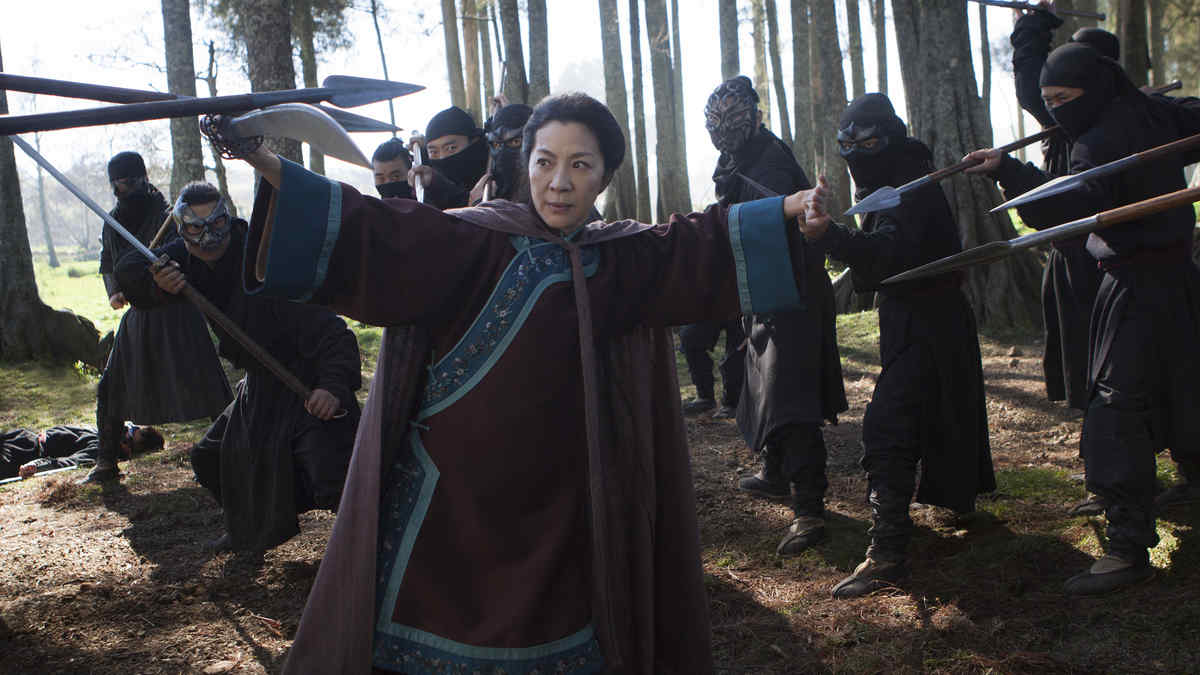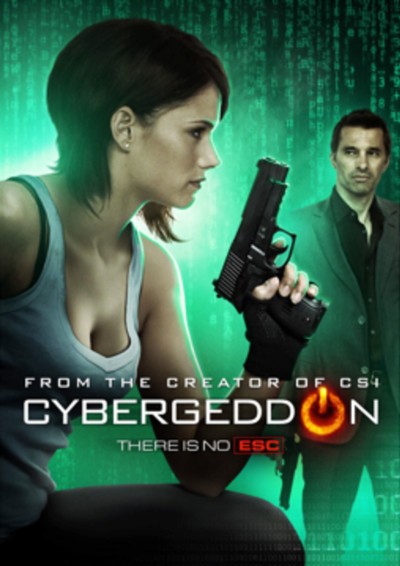★★★½
“Not as good as hoped, yet not as bad as feared.”
 Before we get to the actual sequel, some updated thoughts on the original, which I re-watched, curled up on the couch with Chris for Valentine’s Day. It’s still awesome: absolutely unique, a wuxia epic which was far more successful outside its native China than within it, where the varied accents of its stars caused some criticism. It was a massive hit, far outside the normal boundaries of subtitled movies, and crossing over into mainstream popular culture – as mentioned in our review, when you inspire an advert for Mountain Dew, you’re not in Shanghai any more. It out-grossed Charlie’s Angels in North America, taking in over $128 million – and that was 15 years ago, the equivalent of over $200 million at current prices. For comparison, no foreign-language film in 2015 even reached ten million.
Before we get to the actual sequel, some updated thoughts on the original, which I re-watched, curled up on the couch with Chris for Valentine’s Day. It’s still awesome: absolutely unique, a wuxia epic which was far more successful outside its native China than within it, where the varied accents of its stars caused some criticism. It was a massive hit, far outside the normal boundaries of subtitled movies, and crossing over into mainstream popular culture – as mentioned in our review, when you inspire an advert for Mountain Dew, you’re not in Shanghai any more. It out-grossed Charlie’s Angels in North America, taking in over $128 million – and that was 15 years ago, the equivalent of over $200 million at current prices. For comparison, no foreign-language film in 2015 even reached ten million.
And re-watching it, you can see why, because it remains totally wonderful. I was chatting about it with Werner, and came to the conclusion it works because the film provides a very rare combination of action and heart. There are movies with great, arguably, better action. There are movies with poignant and affecting love stories that tug on the heart-strings. There are very, very few which have both, and the combination is magnificent. At the time, seems I was a bit sniffy about the heavily wire-assisted action; I think I’ve mellowed since for that really didn’t impinge on my enjoyment at all. I may even have undersold the gymnasium duel between Yu Shu Lien (Michelle Yeoh) and Jen Yu (Zhang Zi-Yi). This is not just the greatest female-female battle in cinema history, it may be the finest weapons fight ever.
Yet, without the twin love stories that are entwined here, it would be meaningless (if enjoyable) spectacle. Werner questioned my original casual dismissal of the relation between Jen Yu and barbarian boyfriend Lo (Chang Chen) as “Stockholm syndrome,” and that’s probably fair criticism: it’s clear they do develop a mutual attraction, though I still think it’s also true she was looking for an escape route from the rapidly approaching loveless marriage. I do prefer the unspoken simplicity of the unfulfilled mutual longing between Yu Shu Lien and Li Mu Bai (Chow Yun-Fat). It’s almost harder rewatching this, knowing how it’s going to end. When he says, “I would rather be a ghost, drifting by your side as a condemned soul, than enter heaven without you. Because of your love, I will never be a lonely spirit,” not a dry eye in the house. Or, at least, in our house.
 So, quite some high bar for any sequel to match, and it’s probably inevitable that the sequel falls short. On its own, this would probably be considered a perfectly enjoyable slab of kung-fu action, but to minimize the risk of such comparisons, the makers should probably have stepped further away from its predecessor. Because comparisons become almost inevitable, given this mirrors the original’s structure so closely. That’s especially true in the relationship department where as before, we have two couples: the older pair set apart by circumstance, the younger one brought together the same way. Yu Shu Lien (Yeoh) is reunited with Silent Wolf (Yen), a man to whom she was once betrothed before his disappearance. Meanwhile, Wei-Fang (Shum) is out to steal the Green Destiny for his master, Hades Lee, only to be stopped by wannabe warrioress, Snow Vase (Bordizzo), and the pair begin their own tempestuous relationship.
So, quite some high bar for any sequel to match, and it’s probably inevitable that the sequel falls short. On its own, this would probably be considered a perfectly enjoyable slab of kung-fu action, but to minimize the risk of such comparisons, the makers should probably have stepped further away from its predecessor. Because comparisons become almost inevitable, given this mirrors the original’s structure so closely. That’s especially true in the relationship department where as before, we have two couples: the older pair set apart by circumstance, the younger one brought together the same way. Yu Shu Lien (Yeoh) is reunited with Silent Wolf (Yen), a man to whom she was once betrothed before his disappearance. Meanwhile, Wei-Fang (Shum) is out to steal the Green Destiny for his master, Hades Lee, only to be stopped by wannabe warrioress, Snow Vase (Bordizzo), and the pair begin their own tempestuous relationship.
Yeoh is the only returning character from the first film, and she is every bit as good at providing the film’s emotional heart – and still appears a remarkable bad-ass at age 53! No problems there. The main issue is probably Yen, who is not Chow Yun-Fat. If you want an illustration of the difference between “actors doing martial arts” and “martial artists doing acting,” you can compare and contrast Yen and Chow in these two films. The former can be faked, with a little physical prowess, and some technical know-how. The latter? Not so much, which leaves all the emotion to come from one side, and it simply isn’t as effective. As noted above, the first film was a near-perfect combination of that emotion and dazzling action; the latter sees its talents much more heavily-skewed towards the choreography, which drops it back in line with a thousand and one other genre entries.
Not that this is a bad thing, not when you have Yuen at the helm, since he has been responsible for some of the most brilliant fight scenes in cinema history, from The Matrix to… Crouching Tiger, Hidden Dragon. No-one can match his talents for originality and inventiveness, best showcased here in a battle on a frozen lake that is as much skating as kung-fu. It does need a singular sequence of action heroine goodness; while both Bordizzo and Yeoh have their moments, there’s nothing as exquisite as the Yeoh/Zhang duel. There are some occasionally clunky moments of CGI, which we could probably have done without – two fighters crashing through the balconies of a tower appears to have strayed in from Dead or Alive – but Yuen makes good use of some lush New Zealand locations, even if I did occasionally expect to see Frodo and friends pop out from behind a shrub.
It was made in English, for purely commercial reasons – North American audiences still have issues with subtitles, but once you get over the surprise of seeing Chinese actors, in a film set in China, speaking English, it’s not a significant issue. Both Yeoh and Yen spent their teenage years in the West, so there’s none of the “English as a second acting language” you get with, say, Jet Li’s Hollywood productions. On the edges, there are a couple of other, potentially interesting female characters, Silver Dart Shi (Juju Chan) and a blind sorceress (Eugenia Yuan), although neither get enough screen time to be more than vague constructs. Overall, there’s more than a hint of The Force Awakens here, in that both films are rather too beholden to what has gone before, instead of forging their own path, and suffer in the comparison as a result. And like Awakens, this is still entertaining enough on its own merits to be entirely acceptable. However, I’d probably recommend you do not watch the original the previous weekend, because that is not a battle this movie has any hope of winning.
Dir: Yuen Wo-Ping
Star: Michelle Yeoh, Donnie Yen, Natasha Liu Bordizzo, Harry Shum Jr.































